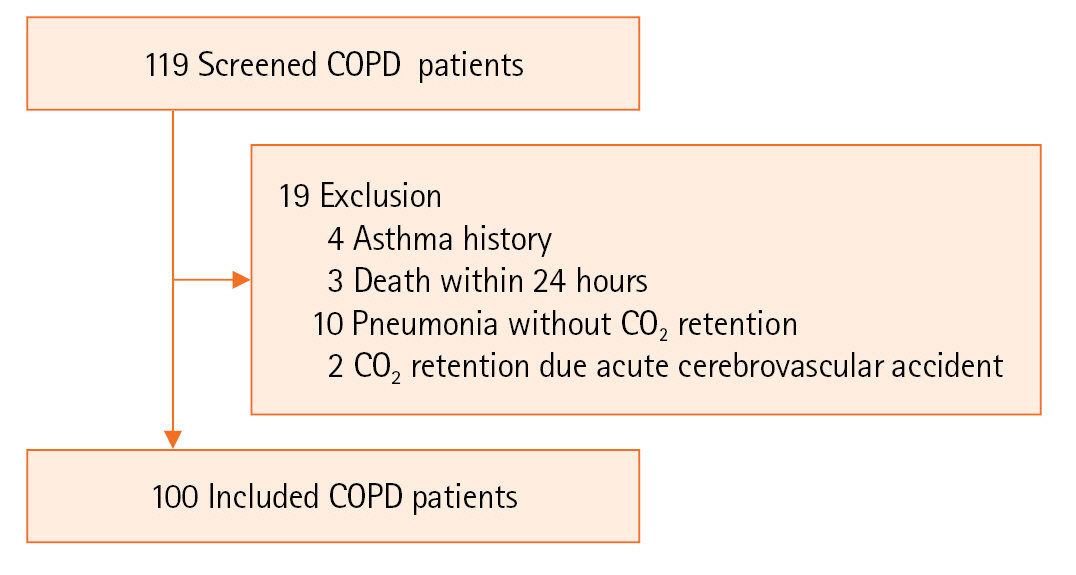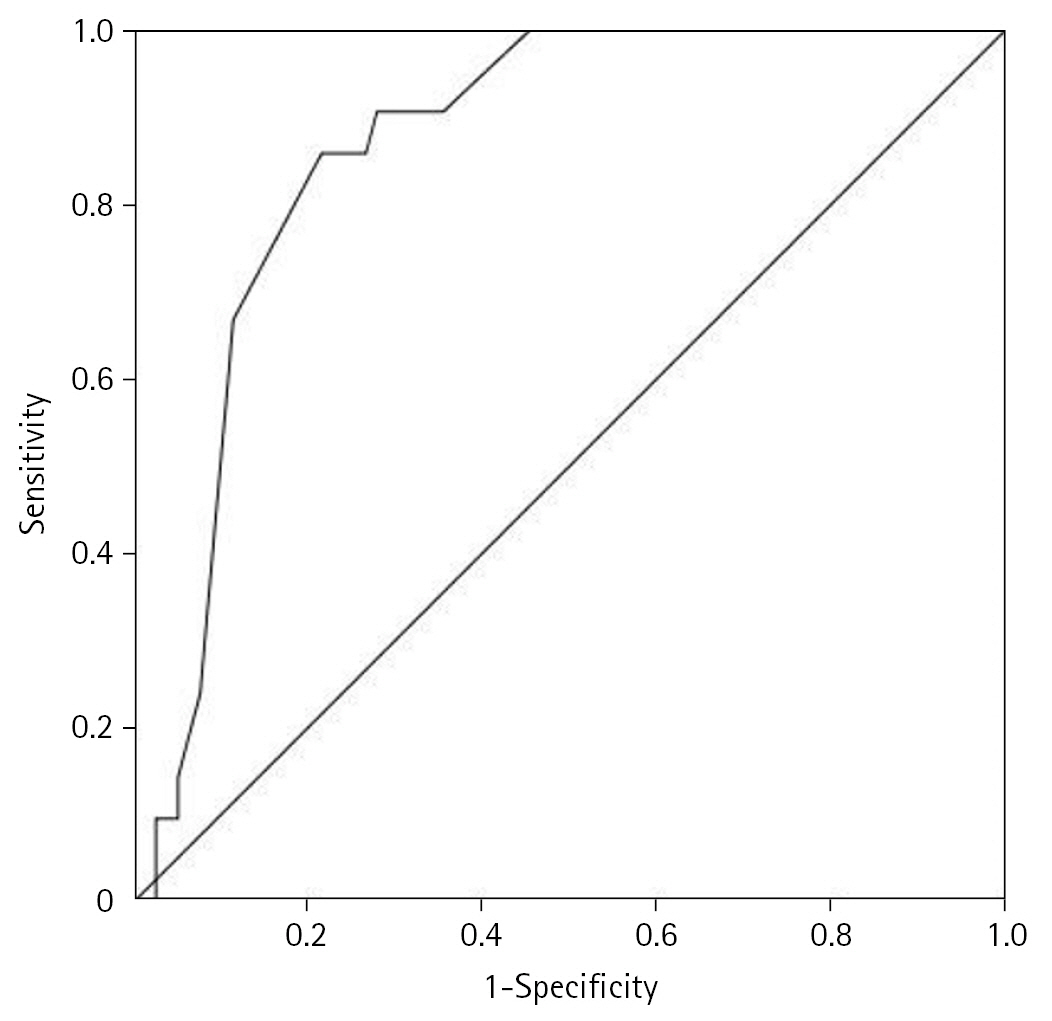Acute Crit Care.
2023 Feb;38(1):49-56. 10.4266/acc.2022.01011.
Characteristics and outcomes of patients with chronic obstructive pulmonary disease admitted to the intensive care unit due to acute hypercapnic respiratory failure
- Affiliations
-
- 1Division of Intensive Care, Department of Internal Medicine, School of Medicine, Düzce University, Düzce, Türkiye
- 2Department of Emergency Medicine, School of Medicine, Balıkesir University, Balıkesir, Türkiye
- KMID: 2540314
- DOI: http://doi.org/10.4266/acc.2022.01011
Abstract
- Background
This study aimed to describe the clinical course, outcomes, and prognostic factors of chronic obstructive pulmonary disease (COPD) patients with acute hypercapnic respiratory failure.
Methods
This retrospective study involved patients with acute hypercapnic respiratory failure due to COPD of any cause admitted to the intensive care unit (ICU) for non-invasive or invasive mechanical ventilation (IMV) support between December 2015 and February 2020.
Results
One hundred patients were evaluated. The main causes of acute hypercapnic respiratory failure were bronchitis, pneumonia, and heart failure. The patients’ mean Acute Physiology and Chronic Health Evaluation (APACHE) II score was 23.0±7.2, and their IMV rate was 43%. ICU, in-hospital, and 90-day mortality rates were 21%, 29%, and 39%, respectively. Non-survivors had greater pneumonia, shock within the first 24 hours of admission, IMV, vasopressor use, and renal replacement therapy, along with higher APACHE II scores, lower admission albumin levels and PaO2/FiO2 ratios, and longer ICU and hospital stays than survivors. Logistic regression analysis identified APACHE II score (odds ratio [OR], 1.157; 95% confidence interval [CI], 1.017–1.317; P=0.026), admission PaO2/FiO2 ratio (OR, 0.989; 95% CI, 0.978–0.999; P=0.046), and vasopressor use (OR, 8.827; 95% CI, 1.650–47.215; P=0.011) as predictors of ICU mortality. APACHE II score (OR, 1.099; 95% CI, 1.021–1.182; P=0.011) and admission albumin levels (OR, 0.169; 95% CI, 0.056–0.514; P=0.002) emerged as predictors of 90-day mortality.
Conclusions
APACHE II scores, the PaO2/FiO2 ratio, vasopressor use, and albumin levels are significant short-term mortality predictors in severely ill COPD patients with acute hypercapnic respiratory failure.
Keyword
Figure
Reference
-
1. Cote CG, Celli BR. Predictors of mortality in chronic obstructive pulmonary disease. Clin Chest Med. 2007; 28:515–24.2. Vogelmeier CF, Criner GJ, Martinez FJ, Anzueto A, Barnes PJ, Bourbeau J, et al. Global strategy for the diagnosis, management, and prevention of chronic obstructive lung disease 2017 report: GOLD executive summary. Am J Respir Crit Care Med. 2017; 195:557–82.3. Berenyi F, Steinfort DP, Abdelhamid YA, Bailey MJ, Pilcher DV, Bellomo R, et al. Characteristics and outcomes of critically Ill patients with acute exacerbation of chronic obstructive pulmonary disease in Australia and New Zealand. Ann Am Thorac Soc. 2020; 17:736–45.4. Seneff MG, Wagner DP, Wagner RP, Zimmerman JE, Knaus WA. Hospital and 1-year survival of patients admitted to intensive care units with acute exacerbation of the chronic obstructive pulmonary disease. JAMA. 1995; 274:1852–7.5. Connors AF, Dawson NV, Thomas C, Harrell FE, Desbiens N, Fulkerson WJ, et al. Outcomes following acute exacerbation of severe chronic obstructive lung disease: the SUPPORT investigators (Study to Understand Prognoses and Preferences for Outcomes and Risks of Treatments). Am J Respir Crit Care Med. 1996; 154(4 Pt 1):959–67.6. Afessa B, Morales IJ, Scanlon PD, Peters SG. Prognostic factors, clinical course, and hospital outcome of patients with chronic obstructive pulmonary disease admitted to an intensive care unit for acute respiratory failure. Crit Care Med. 2002; 30:1610–5.7. Ucgun I, Metintas M, Moral H, Alatas F, Yildirim H, Erginel S. Predictors of hospital outcome and intubation in COPD patients admitted to the respiratory ICU for acute hypercapnic respiratory failure. Respir Med. 2006; 100:66–74.8. Gadre SK, Duggal A, Mireles-Cabodevila E, Krishnan S, Wang XF, Zell K, et al. Acute respiratory failure requiring mechanical ventilation in severe chronic obstructive pulmonary disease (COPD). Medicine (Baltimore). 2018; 97:e0487.9. Rivera-Fernández R, Navarrete-Navarro P, Fernández-Mondejar E, Rodriguez-Elvira M, Guerrero-López F, Vázquez-Mata G, et al. Six-year mortality and quality of life in critically ill patients with chronic obstructive pulmonary disease. Crit Care Med. 2006; 34:2317–24.10. Plant PK, Owen JL, Elliott MW. Early use of non-invasive ventilation for acute exacerbations of chronic obstructive pulmonary disease on general respiratory wards: a multicentre randomised controlled trial. Lancet. 2000; 355:1931–5.11. Comellini V, Pacilli AM, Nava S. Benefits of non-invasive ventilation in acute hypercapnic respiratory failure. Respirology. 2019; 24:308–17.12. Pincelli MP, Grumann AC, Fernandes C, Cavalheiro AG, Haussen DA, Maia IS. Characteristics of COPD patients admitted to the ICU of a referral hospital for respiratory diseases in Brazil. J Bras Pneumol. 2011; 37:217–22.13. Ai-Ping C, Lee KH, Lim TK. In-hospital and 5-year mortality of patients treated in the ICU for acute exacerbation of COPD: a retrospective study. Chest. 2005; 128:518–24.14. Breen D, Churches T, Hawker F, Torzillo PJ. Acute respiratory failure secondary to chronic obstructive pulmonary disease treated in the intensive care unit: a long term follow up study. Thorax. 2002; 57:29–33.15. Berkius J, Nolin T, Mårdh C, Karlström G, Walther SM; Swedish Intensive Care Registry. Characteristics and long-term outcome of acute exacerbations in chronic obstructive pulmonary disease: an analysis of cases in the Swedish intensive care registry during 2002-2006. Acta Anaesthesiol Scand. 2008; 52:759–65.16. Nicholson JP, Wolmarans MR, Park GR. The role of albumin in critical illness. Br J Anaesth. 2000; 85:599–610.17. Freire AX, Bridges L, Umpierrez GE, Kuhl D, Kitabchi AE. Admission hyperglycemia and other risk factors as predictors of hospital mortality in a medical ICU population. Chest. 2005; 128:3109–16.18. Fan E, Brodie D, Slutsky AS. Acute respiratory distress syndrome: advances in diagnosis and treatment. JAMA. 2018; 319:698–710.19. Wagner PD. Assessment of gas exchange in lung disease: balancing accuracy against feasibility. Crit Care. 2007; 11:182.20. Ware LB. Prognostic determinants of acute respiratory distress syndrome in adults: impact on clinical trial design. Crit Care Med. 2005; 33(3 Suppl):S217–22.
- Full Text Links
- Actions
-
Cited
- CITED
-
- Close
- Share
- Similar articles
-
- Successful noninvasive ventilation in a severely acidotic and hypercapnic comatose COVID-19 patient with multiple comorbidities: a case report
- Desaturaton due to Acute Exacerbation of Chronic Obstructive Pulmonary Disease in the Patient Who Underwent the Cephalic Vein Bypass Surgery under Epidural Anesthesia
- Acute Respiratory Failure after Embolectomy in Patient with Chronic Pulmonary Embolism: A case report
- Current status of treatment of acute respiratory failure in Korea
- Utility of the DECAF Score in Patients Admitted to Emergency Department with Acute Exacerbation of Chronic Obstructive Pulmonary Disease



